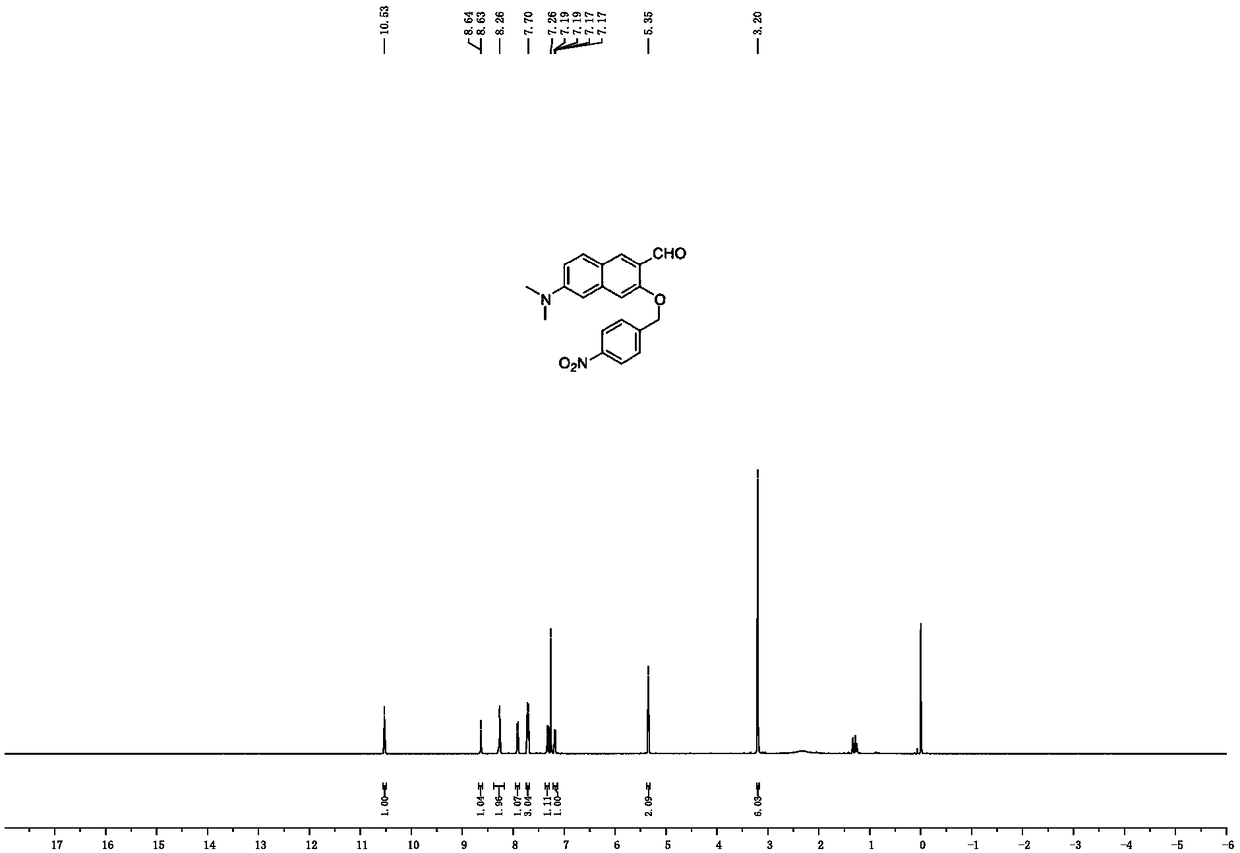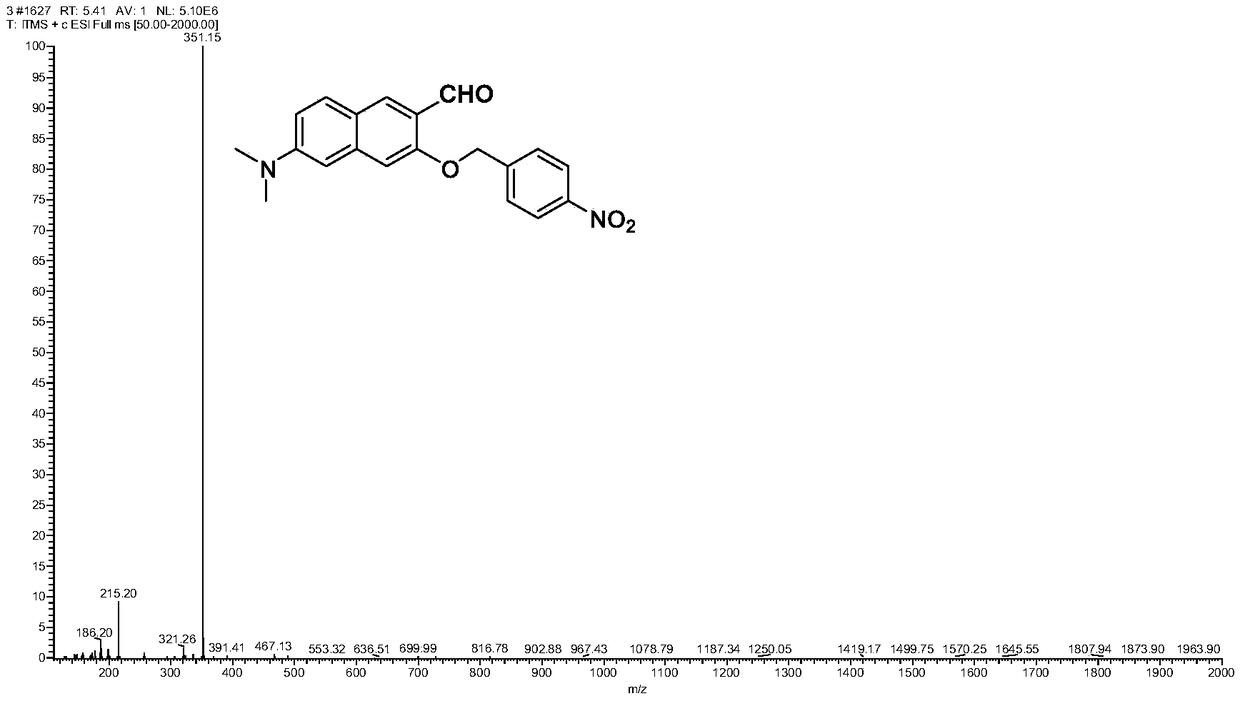Probe capable of realizing two-photon fluorescence detection of nitroreductase (NTR) and preparation method thereof
A two-photon fluorescence, nitroreductase technology, applied in the field of organic fluorescent probes, can solve the problems of small Stokes shift, interference, poor water solubility of the probe, and achieve good cell permeability, avoid interference, and improve The effect of chemical stability
- Summary
- Abstract
- Description
- Claims
- Application Information
AI Technical Summary
Problems solved by technology
Method used
Image
Examples
Embodiment 1
[0035] The preparation method of a series of naphthol-based fluorophore two-photon nitroreductase (NTR) probe XD03 is as follows:
[0036] 1.1XD00: 2,7-dihydroxynaphthol (0.3g, 18.7mmol), dimethylamine (40% aqueous solution, 1.05mL, 9.35mmol), sodium metabisulfite (0.711g, 3.74mmol), deionized water 2mL in sequence Add it into a Shrek bottle, react at 150°C for 8 hours, cool to room temperature, use hydrochloric acid to adjust the pH of the reaction system to about 4, then use DCM to extract and spin dry, and purify by gel column chromatography to obtain the intermediate product XD00. 1 H-NMR (300MHz, CD 3 OD): δ7.57(m, 2H), δ6.97-7.01(m, 1H), δ6.93-6.94(d, J=3Hz, 1H), δ6.67-6.79(m, 2H), δ2 .98(S,6H), the reaction formula is as follows:
[0037]
[0038]1.2XD01: Add N,N-dimethylformamide (0.4mL) to the Shrek bottle and vacuumize, add phosphorus oxychloride (0.2mL) to the above Shrek bottle with a syringe, and place it in a cold well at 0°C under stirring for 10min. The ...
Embodiment 2
[0045] The preparation method of a series of two-photon nitroreductase (NTR) probe XD03 based on naphthol fluorophore is as follows:
[0046] 1.1XD00: Add 2,7-dihydroxynaphthol (3g, 187mmol), dimethylamine (40% aqueous solution, 10.5mL, 93.5mmol), sodium metabisulfite (7.11g, 37.4mmol), and 20mL of deionized water to the mixture in turn. In a Shrek bottle, react at 150 °C for 8 h, and after cooling to room temperature, use hydrochloric acid to adjust the pH of the reaction system to about 4, then use DCM to extract and spin dry, and purify by gel column chromatography to obtain an intermediate product white solid XD00.
[0047] 1. 2XD01: Add N,N-dimethylformamide (4mL) to the Shrek bottle and vacuumize, add phosphorus oxychloride (2mL) to the above Shrek bottle with a syringe, and stir at 0°C in a cold well 10min. The product XD00 from the previous step was dissolved in 2 mL of N,N-dimethylformamide, slowly added to the Shrek bottle with a disposable syringe, and stirred at 0...
Embodiment 3
[0051] The preparation method of a series of two-photon nitroreductase (NTR) probe XD03 based on naphthol fluorophore is as follows:
[0052] 1.1XD00: 2,7-dihydroxynaphthol (1.5g, 93.5mmol), dimethylamine (40% aqueous solution, 5.25mL, 46.75mmol), sodium metabisulfite (3.55g, 18.7mmol), deionized water 10mL in turn It was added to Shrek bottle, reacted at 150°C for 8h, cooled to room temperature, adjusted the pH of the reaction system to about 4 with hydrochloric acid, then extracted with DCM and spin-dried, and purified by gel column chromatography to obtain an intermediate product white solid XD00.
[0053] 1. 2XD01: Add N,N-dimethylformamide (2mL) to the Shrek bottle and vacuumize, add phosphorus oxychloride (1mL) to the Shrek bottle with a syringe, and stir at 0°C in a cold well 10min. The product XD00 of the previous step was dissolved in 1 mL of N,N-dimethylformamide, slowly added to the Shrek bottle with a disposable syringe, and stirred at 0 °C for 2 h. After cooling...
PUM
 Login to View More
Login to View More Abstract
Description
Claims
Application Information
 Login to View More
Login to View More - R&D Engineer
- R&D Manager
- IP Professional
- Industry Leading Data Capabilities
- Powerful AI technology
- Patent DNA Extraction
Browse by: Latest US Patents, China's latest patents, Technical Efficacy Thesaurus, Application Domain, Technology Topic, Popular Technical Reports.
© 2024 PatSnap. All rights reserved.Legal|Privacy policy|Modern Slavery Act Transparency Statement|Sitemap|About US| Contact US: help@patsnap.com










